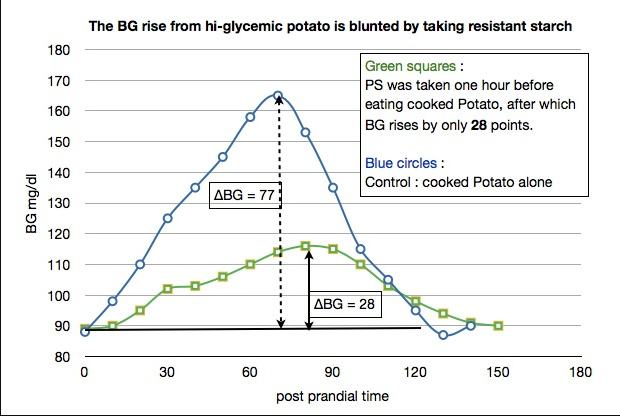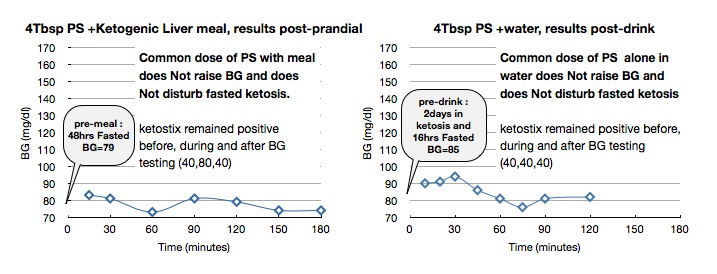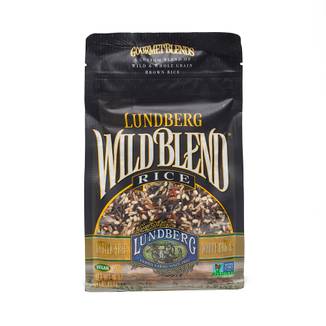Types of Resistant Starch:
Not all resistant starches are the same. There are 4 different types (2).
•Type 1: Is found in grains, seeds and legumes and resists digestion because it’s bound within the fibrous cell walls.
•Type 2: Is found in some starchy foods, including raw potatoes and green (unripe) bananas.
•Type 3: Is formed when certain starchy foods, including potatoes and rice, are cooked and then cooled. The cooling turns some of the digestible starches into resistant starches via retrogradation (3).
•Type 4: Is man-made and formed via a chemical process.
However, this classification is not so simple, as several different types of resistant starch can co-exist in the same food.
Depending on how foods are prepared, the amount of resistant starch changes.
For example, allowing a banana to ripen (turn yellow) will degrade the resistant starches and turn them into regular starches.
How Does It Work?
The main reason why resistant starch works, is that it functions like soluble, fermentable fiber.
It goes through your stomach and small intestine undigested, eventually reaching your colon where it feeds your friendly gut bacteria (4).
The bacteria in your intestine (the gut flora) outnumber the body’s cells 10 to 1 — in that respect, you’re only 10% human (5).
Whereas most foods feed only 10% of your cells, fermentable fibers and resistant starches feed the other 90% (6, 7).
There are hundreds of different species of bacteria in your intestine. In the past few decades, scientists have discovered that the number and type of bacteria can have a profound impact on your health (8, 9).
Resistant starch feeds the friendly bacteria in your intestine, having a positive effect on the type of bacteria as well as their number (10, 11).
When the bacteria digest resistant starches, they form several compounds, including gases and short-chain fatty acids, most notably butyrate (12, 13). …More
”…New research shows that resistant starch helps the body resist colorectal cancer through mechanisms including killing pre-cancerous cells and reducing inflammation that can otherwise promote cancer. …More
2. Resistant Starches, Butyrate, and Your Gut, Oh My! - Dr. Stephanie Estima
“There are receptors to these molecules in your immune system, in your gut and in your heart. So when you say, ‘I have a gut feeling’ or ‘my heart is sad’ or ‘I am bursting with joy,’ you’re not speaking metaphorically. You’re speaking literally.” - Deepak Chopra
Often forgotten is looking at the relationship between your gut and your brain.
When you are on a dirty keto program, one of the most common complaints is by week 2 or 3 you are starving. More correctly, it is your microbiome that is starving.
Part of the way we blunt this hunger response is via resistant starches. In other words, starches that “resist” digestion. These are abundantly found in oats, green banana flour, legumes, and beans.
On a traditional ketogenic diet, with a standard Fat:Protein:Carb ratio of 70–20–10, what I have often found is you are absolutely starving by about week 3 and will overeat and binge on protein, and carbs.
This is why most people “fail” at keto.
However, when we integrate fiber and resistant starches into the picture, this hunger response is blunted.
Look at this experiment on consuming resistant starches and the blunting effect on post prandial blood glucose levels.
In this graph, they are looking at the effects of taking resistant starches, followed by a high glycemic food. When taking resistant starches, the effect on blood glucose levels are outstanding compared to the baseline — a 28 point rise compared to almost 170.
When in a state of ketosis (either through a fasted state or via a fasting mimicking diet like keto), consuming resistant starches does not disturb this state:
Resistant starches are great for a ketogenic diet — they blunt your hunger response, and also blunt elevated blood glucose levels when carbohydrates are consumed.
Part of why resistant starches are so great is instead of being digested, they are selectively feeding the “good” microbiota in our gut.
As these microbiota chow down on the resistant starches, they will produce short chain fatty acids as a by product of their meal. Of particular importance here is the short chain fatty acid known as butyrate.
Butyrate has a whole host of beneficial effects.
One important one is decreasing gut permeability.
When the lining of the gut is more permeable, we are more susceptible to developing food allergies, food intolerances, and an overall immune system on high alert all the time.
Having an increased permeability of the gut has been associated with almost all proinflammatory conditions, including most autoimmune conditions, fatty liver, and heart disease.
Inflammation is the linchpin to most lifestyle diseases.
One of the primary objectives we must look at in any health protocol is to heal the gut.
The obvious reason here is it makes digesting food a more pleasant and efficient experience. We all want to be able to eat without gas, bloating, indigestion, or diarrhea.
But it is the knock on positive benefits to our neurology that is of particular long term importance.
The gut has its own nervous system — the enteric nervous system — which has strong communication pathways with the brain and central nervous system.
A little nerding out for my neuronerds:
•Developmentally, the enteric nervous system is made from neural crest cells. Specifically the vagal neural crest cells…which is why we have such strong gut reactions to stimuli. A “gut feeling” is the communication between the central and enteric nervous systems via the vagus nerve.*
•Ever feel nervous about something and then immediately have to go to the bathroom, or feel like you were going to throw up? It is because of the strong vagal tone and communication between a perceived stimuli in your brain, and the enteric nervous system in the gut.*
I know. So cool, right?!*
The communication between the gut and the brain is paramount, and making sure your enteric nervous system is aligned with your autonomic nervous system should be a goal in any nutrition program.
So when we feed the microbiome and they produce butyrate levels are high, you allow for gut healing to occur…but it is also important in brain health.
The butyrate effect is the gift that keeps on giving.
Butyrate helps keep the brain healthy by upping the expression of neurotrophic factors.
Butyrate, and the structurally similar B-hydroxybutyrate (which is produced in a ketogenic state) help increase BDNF (Brain-Derived Neurotrophic Factor), GDNF (Glial-cell derived Neurotrophic Factor) and NGF (Nerve Growth Factor).
All of these help in the maintenance of nerve cells that you already have, but also help grow new, healthy nerve cells.
In other words — butyrate, and B-hydroxybutyrate keep your brain big and juicy. …More
- Impact of Dietary Resistant Starch on the Human Gut Microbiome, Metaproteome, and Metabolome “… The combined data showed that a high-RS diet caused an increase in the ratio of Firmicutes to Bacteroidetes, including increases in relative abundances of some specific members of the Firmicutes and concurrent increases in enzymatic pathways and metabolites involved in lipid metabolism in the gut. …”




 from a small region of the North American continent and traditionally gathered & eaten on the sacred lands of the Annishnaabe and Ojibwa peoples.
from a small region of the North American continent and traditionally gathered & eaten on the sacred lands of the Annishnaabe and Ojibwa peoples. These are a few of my favorite things
These are a few of my favorite things